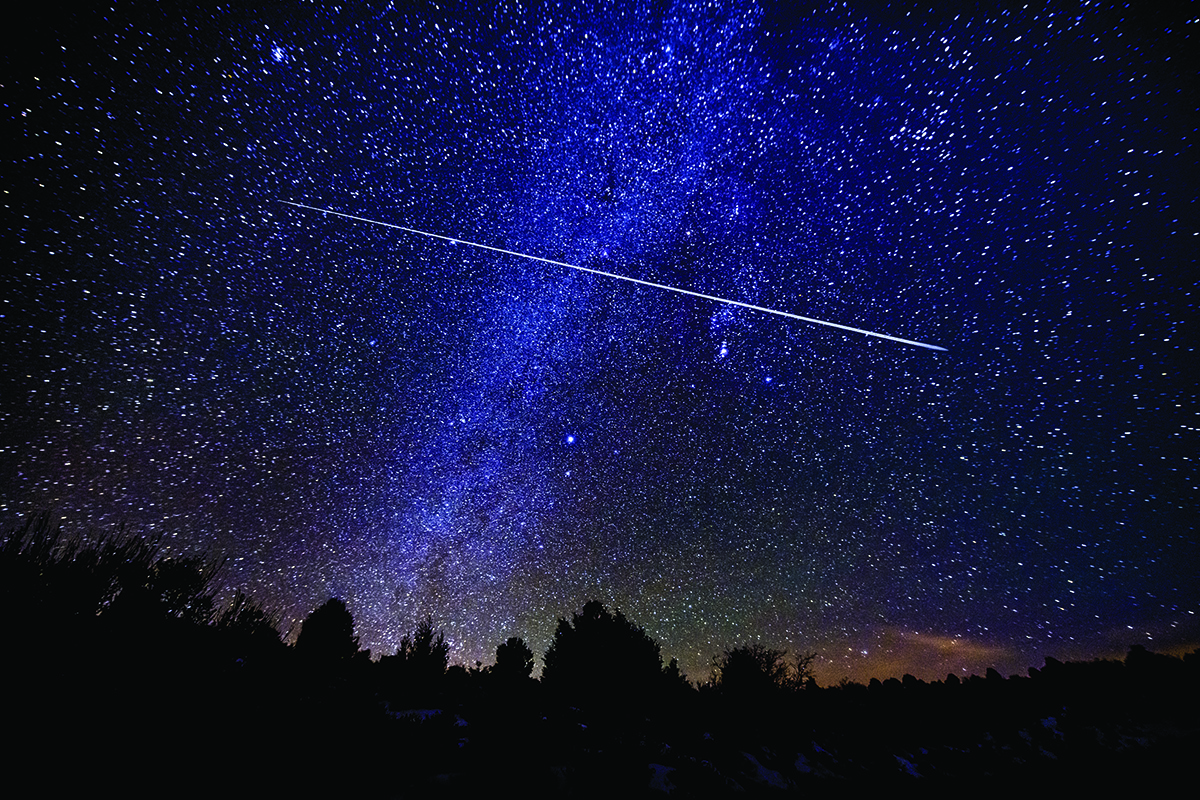For decades, children have looked to the night sky in search of a shooting star so they could make a treasured wish. Shooting stars are actually called meteors, but the beloved Disney song would somehow not be the same with the corrected name. In addition to providing hope to children, the heavens have afforded a wealth of information since the beginning of time. Sailors and shepherds could often be heard saying, “A red sky at night is a sailor’s delight,” and “A red sky in the morning, shepherd’s warning.” This information is helpful to all, as a red night sky means good weather is coming, and a red sky in the morning means pack an umbrella. Farmers also see the usefulness of reading the sky. The constellations and moon phases have long guided them to the best times to plant and harvest their crops. Astronomers search the sky and beyond to discover hidden secrets and to learn more about phenomena visible to the naked eye, including meteors.
Meteors, often referred to as shooting stars, are really pieces of asteroids or comets called meteoroids. When the kinetic energy of these pieces hit the Earth’s atmosphere, they burn up creating the flash of light we see in the sky. It is this flash of light that is called a meteor. Meteors are more commonly pieces of comets and often burn up before reaching the Earth’s surface. You are more likely to see a meteor in the fall, shortly before sunrise, but they do appear at other times.
Sometimes a single meteor will streak across the night sky. At certain times of the year, we are treated to a beautiful spectacle called a meteor shower. A meteor shower generally occurs when the Earth, as it orbits, passes through the path of a comet. The debris from the comet burns up causing multiple meteors which are all moving in the same direction. Since the Earth’s orbit does not change, we can expect to see the same meteor showers annually. According to NASA’s website, one of the most dependable meteor showers is the Perseids meteors. So-called because it appears to radiate from the Perseus constellation, the Perseids meteor shower has been an annual event for more than 2,000 years. Every August, the Comet Swift-Tuttle’s orbit is close enough to Earth for its particles to be pulled into the Earth’s gravitational field creating a magnificent show in the night sky.
The tireless work of scientists in the fields related to astronomy has led to increased knowledge of what we see outside our planet. Because of this awareness, we can both enjoy and respect the enormity of the universe around us. In modern times, a meteor shower is an exciting event that brings you closer to the mysteries of the heavens, but for some civilizations, a meteor shower was a message or even an omen for the future. In the past, cultures have thought that meteor showers were a sign from the dead indicating they made it to the afterlife. Other cultures viewed meteor showers as a sign that the gods were angry with them. Some historical cultures believed that three meteor sightings in one night indicated that death was coming. Gratefully, we now understand that a meteor is an explainable occurrence and not a sign of impending doom.
So, if you too believe that a meteor shower is a sight to behold (and not a bad omen), you have several opportunities to view one for yourself. Take your family and friends, head to a place outside the city lights, and look to the stars. This chart has the most visible annual meteor showers, and you don’t want to miss their dazzling display. Remember to make a wish!
| Name of Meteor Shower | Best Time to View | Origin of Shower | Dates of Best Viewing | Number of Meteors Per Hour | Comet Name |
| Delta Aquarid | Predawn | Dates of Best Viewing | July 29 – 30 | 10 | |
| Perseid | Predawn | South | August 11 – 13 | 50 | Swift-Tuttle |
| Draconid | Late Evening | July 29 – 30 | October 8 – 10 | 6 | Giacobini -Zinner |
| Orionid | Predawn | Northeast | October 20 – 21 | 15 | Halley |
| Northern Taurid | Late Evening | August 11 – 13 | November 11 -12 | 3 | Encke |
| Leonid | Predawn | Northwest | November 16 – 18 | 10 | Tempel-Tuttle |
| Andromedid | Late Evening | October 8 – 10 | November 25 – 27 | 5 | Biela |
| Geminid | All Night | South | December 13 – 14 | 75 | |
| Ursid | Predawn | October 20 – 21 | December 21 – 22 | 5 | Tuttle |








